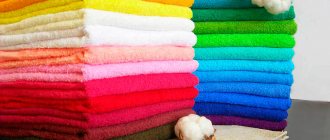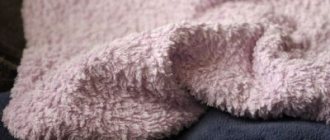Terry towels must be washed before first use.
To keep 100% cotton terry products soft and fluffy, do not wash terry fabric (which absorbs water well) on the water saving mode and at very high speeds (max. 800). The loops may stretch due to friction with the washing machine drum. This can be avoided by filling the drum at least 2/3 full.
Due to the thin structure and convex parts (loops), terry products should not be pinched, squeezed or rubbed. Never wash terry towels and robes together with items containing snaps or hooks. They can tear terry cloth brooms.
To maintain the intensity of the colors, use a detergent designed for colored laundry. When purchasing a conditioner, we recommend that you pay attention to its composition and buy one that contains silicone, which helps increase the absorbency of terry fabric.
In order for terry products to retain their basic qualities, they must be kept in salted water and rinsed well. Salt has a beneficial effect on terry fabric, helping it fluff up and return to its original qualities.
Terry fabric items are best dried in the fresh air, although they also respond well to machine drying. This procedure makes them softer and fluffier without the use of special softeners or rinsing, which will help save your money, effort and time.
Large terry products - bathrobes, bed linen - take about a day to dry. Terry towels usually take half this time to dry completely and be ready for use.
Terry towels and bathrobes are not recommended to be ironed. Because of this, the loops of the fabric may become wrinkled, causing the towel to lose its fluffiness and softness. This is especially true for velor products and products made from single loop yarn, which will look more voluminous without ironing.
After washing in slightly salty water, it is best to simply hang terry towels out to dry. Decorative elements that people love to decorate terry towels with - borders, embroidery, appliqués - can be treated with a cool iron if desired.
If the need to iron a terry towel is very great, then this must be done very delicately and following certain rules. The temperature of the hot surface of the iron when ironing terry towels should be no more than 150 degrees Celsius. Items made from terry fabric should be ironed through a slightly damp cloth or with an iron with a steam humidifier. And, nevertheless, it is better not to do this, because using an iron terry fabrics lose their main quality - softness and tenderness. Think about this before plugging in your iron.
Many housewives prefer not to iron terry towels at all after washing, so as not to deprive the fleecy fabric of its softness. But the lack of ironing is not always justified, because the iron helps to further disinfect home textiles.
Do I need to iron baby clothes?
Ironing baby
things to kill excess germs are only really important for children with serious skin conditions where the skin is constantly cracking, inflamed and not performing its protective function properly.
Interesting materials:
How to view history in a standard Android browser? How to view history in Telegram? How to view Viber history on a computer? How to view Viber history? How to view WhatsApp history anonymously? How to view your email login history? How to view your login history on Steam? How to view your Google login history? How to view your Google tab history? How to view tab history in Safari?
Do terry towels need to be ironed?
Hot steam has a negative effect on the condition of the villi. Terry towels become hard and rough, absorb water worse, and are unpleasant to use. Housewives are especially worried if towels for a child’s delicate skin become like sandpaper.
But it is worth noting that it is not only the iron that makes the item less pleasant and functional. This is also aggressive and frequent washing at high temperatures, bad powders that do not rinse out of fabric fibers, quick spinning, drying on a radiator, ignoring special softening conditioners.
Small lint loops deteriorate not only from a hot iron, but also from increased pressure. When you press them hard with an iron, the fabric loses its airiness.
In what cases can and should you iron a terry towel:
- If it's a child's item.
- If the product is old.
- If you visited public places, the beach.
Carry out the procedure to disinfect the product. To prevent it from becoming wrinkled, straighten it after washing and dry it in a horizontal position, do not use clothespins or ropes.
What to use when washing
Choose liquid laundry detergents that contain balms and silicone. This will make things fluffy.
There is a large selection of household chemicals on sale, designed specifically for soft fabrics.
Regular laundry soap is suitable as a cheap alternative. It can be used for both hand and machine washing.
It is better to give preference to household chemicals that do not contain chlorine and phosphates.
Dry laundry detergent is not the best product for fluffy items. Bleach is also not suitable for them. Try to avoid these remedies.
It is also better to avoid conditioners, although they make the towel softer, but at the same time they have a detrimental effect on it; the towel begins to absorb moisture worse, and this is the main property of terry fabric.
Pre-soaking terry towels
How to wash a terry towel if it is very dirty? In this case, the pre-soaking step will help. This procedure will help to better remove various stains. And vinegar added to the water will keep the structure of the towel soft and delicate.
The proportions for preparing the solution are as follows: 15-20 milliliters of vinegar per 1 liter of warm water. In addition, soaking towels in this way helps remove even stubborn stains, for example from grease.
How to store and use correctly
- Store towels in a dry, ventilated area. Do not place them in the bathroom under any circumstances: terry cloth will instantly absorb moisture, which may result in mold and an unpleasant odor.
- Do not leave the towel wet. This should not be done for the previous reason. And under no circumstances should you throw a towel or robe into the basket with other dirty items.
- Change towels at least once every 3-5 days.
Basic rules for washing terry towels
Basic tips for washing terry products are as follows:
- It is recommended to use special canvas or mesh bags to prevent towels from rubbing against the drum of the washing machine.
- It is necessary to separate white products from colored ones to avoid shedding. Although modern dyes are durable, sometimes it happens that light-colored towels are accidentally stained.
- It is not recommended to wash terry towels with products that are decorated with metal or plastic elements. These hard parts can damage the pile.
- Do not wash a wet towel. It must be dried first. Otherwise, a musty smell may occur. If such an unpleasant odor has already arisen, it is recommended to air the towel in the fresh air for several hours, and then wash it as usual.
“Taboo” for terry towels
An invigorating shower or warm bath with aroma oils. Everyone dreams of this, especially after a hard day’s work. Gentle touches, soft movements, a fluffy wave of terry loops after a shower, bath or sauna gives its owner a towel. But this is provided that it is really tender and fluffy. But very often, a new terry cloth ceases to please and relax, but, on the contrary, stresses and irritates.
Why are terry towels hard after washing? A question that worries everyone: both those who take care of their fluffy hair, and those whose bodies are accustomed to the gentle touches of the hair. Housewives, administrators of hotels, hotels, saunas and sports complexes are daily looking for ways (both improvised and professional) to fill personal hygiene items with fluffiness and tenderness. The towels have become hard because the washing and rinsing process is disrupted, inappropriate products are used, and poor quality water is used for washing.
Why does terry become rough?
Some housewives believe that if they wash their towels in the usual way, nothing bad will happen. However, they are deeply mistaken. Products become hard due to the following errors:
- using conventional powder with large abrasive particles;
- low quality detergent;
- regularly wash towels in hard water;
- boiling and digestion;
- spin at more than 800 rpm;
- lying for a long time in a dirty or damp state (in addition, this creates an unpleasant odor, which is difficult to get rid of or mold grows in the terry);
- Ironing at high temperature.
Traditional washing methods
Observations of natural processes, coupled with ingenuity, give rise to folk washing methods. They are often effective and capable of resuscitating the thing they were planning to get rid of. And the variety of methods is amazing.
Methods for reviving towels are varied.
The most popular, according to Internet users:
- with vegetable oil;
- boiling;
- using a mixture of mustard powder and boric acid and even in the microwave!
You can use traditional methods to make towels soft.
Each of the methods, tested over generations, deserves special attention.
Note! You should not try untested washing methods about which there is no reliable information (at least reviews).
It's always better to use proven methods.
With vegetable oil
An amazing method that has already become popular among people is washing towels with vegetable oil. The main advantage of the method is not only its effectiveness, but also the availability of the main material, vegetable oil. With its help, you can eliminate traces of fat, soot, tea, coffee, etc. In practice, it is implemented as follows:
- Heat a bucket of water to a boil. When the liquid boils, you need to place 20 mg of vegetable oil there. Additional elements will be 20 g of bleach, 30 g of soda and 50 g of powder.
- After removing the bucket from the stove, you need to pour half a glass of table vinegar into it.
- Place dry towels that need washing inside and leave to soak until the water cools.
- You need to rinse in clean water.
An unusual way to wash towels is using vegetable oil.
There are many similar methods. The differences between them are minor.
In the microwave
An extraordinary method is to wash towels in the microwave. The auxiliary substances are washing soap and a simple bag. The procedure itself looks like this:
- The towel needs to be wetted and soaped properly, and then sent to the bag. There is no need to tie it. Place the bag with the towel in the microwave for 1.5 minutes, selecting medium power.
- When you take the towel out of the microwave, you need to rinse it thoroughly.
Kitchen towels are usually washed in the microwave.
Note! The method is really simple. But it is mainly applicable to linen and cotton waffle towels.
With boiling
Exposure to high temperatures does not always benefit fabric materials. If you intend to clean your towels using boiling water, then you need to do it safely. The algorithm looks like this:
- we select containers (it can be an enameled or galvanized pan, bucket, container);
- an additional effect can be obtained by adding 2-3 tablespoons of persalt per 5 liters of water or a little ammonia;
- Having brought the water to a boil over high heat, we continue to boil things for 30 minutes - 2.5 hours (depending on the degree of contamination);
- Things need to be stirred periodically (for example, with wooden tongs).
You need to boil towels according to certain rules.
After boiling, the towels should be rinsed thoroughly and hung outside to dry.
IMPORTANT! Synthetics do not tolerate high temperatures well, this destroys the fabric and shrinks.
With mustard powder and boric acid
This method is good for bleaching white waffle towels, such as kitchen towels. To implement it you will need: a basin, warm water, a pack of mustard powder and a little boric acid. The process looks like this:
- heat the water to 40-50 degrees;
- pour the contents of a pack of mustard powder into it;
- Stir thoroughly and strain (so that the sediment does not mix with water);
- place towels in a container with the solution and add a little boric acid;
- soak for 30 minutes - 2 hours;
- wash, rinse.
Mustard powder in combination with boric acid whitens fabric well.
Boric acid in this case can also be used at the rinsing stage.
How to soften hard water?
You can soften hard water using traditional methods. Hard water negatively affects the condition of towels. One of the softening options is to install a purifying filter that will remove harmful impurities from the water. Also, improvised means that every housewife has will come to the rescue: soda, salt and vinegar. The substances will ensure the lushness of terry pile and preserve the shade of towels, both colored and snow-white. Soda
Soda delicately softens textiles. Both calcined and edible substances are suitable.
It is enough to pour 3-4 tbsp into the drum. soda The water will soften and the towels will be washed without damage. Salt
Add salt when washing white towels. Regular table salt or an equivalent for automatic washing machines will do.
First option: add 3 tbsp. to the detergent. Second: dissolve the food product in a glass of warm water and pour directly into the tank. Vinegar
In addition, vinegar gets rid of unpleasant odors. Pour ½ cup of a 9% vinegar solution into the conditioner container and start the wash.
Another useful property of vinegar is the elimination of unpleasant odors. Vinegar-soda solution
The tandem of vinegar and salt works wonders. There are several options for simultaneous use of these products. In the first case, pour ½ cup of vinegar into the conditioner container, and pour ½ cup of soda into the drum of the machine. The second option is to make your own conditioner. Mix 1 glass of water, 6 glasses of vinegar 9% and 1 glass of soda. The resulting substance will foam, and then add another 6 glasses of water. If desired, you can add a few drops of essential oil to give the product a pleasant aroma. Pour the solution into a container, use at the rate of ½ cup of liquid per wash. Wash terry items every 3-4 days separately from other items.
Why do towels become stiff after washing: main mistakes
The reasons for the stiffness of terry towels may seem obvious, but to avoid mistakes you need to know about them.
There may be several reasons for the appearance of rigidity.
Among the main culprits of this unpleasant phenomenon:
- incorrect selection of washing mode (rpm too high);
- water quality (may contain heavy impurities or metal);
- incorrect temperature conditions;
- low quality cleaning products;
- attempts to “speed up” drying using heaters and other heat sources.
If not handled correctly, towels can become hard.
Alas, you can’t expect durability from cheap fabric. Although if you make the above mistakes when washing expensive products, they will also quickly lose their physical properties.
One of the reasons for the rapid deterioration of towels is cheap fabric.
How to wash towels to keep them soft
Proper care will preserve the softness and hygiene, cleanliness and freshness, original color and aesthetic appearance of terry towels for a long time. Experts advise changing bath towels after three to five uses, products for the kitchen, hands and face - at least every other day, and for feet - every three days.
Before washing, drying or ironing towels, be sure to read the label. Follow the recommendations to avoid damaging the fabric. Such products are washed in a large volume of water, at a high number of revolutions (up to 800) and with long, thorough rinsing.
For washing, choose a temperature of 40-60 degrees. To ensure that terry towels remain soft after washing, place special plastic laundry balls in the drum of the washing machine along with the product. Products must be washed separately from other items. There should be room in the machine, so fill the drum only half or three-quarters full.
To keep your towels soft and fluffy, it is best to hand wash them. Choose only gels and other liquid laundry detergents, as the powder is difficult to wash out and remains in the fibers of the fabric, making the material tough. Sometimes you can use fabric softener. But do not overuse the product, as it impairs the absorbency of materials.
Second life for old towels
Our life hacks will help not only extend the “shelf life” of new towels, but also restore the original appearance of old ones. Hard fibers
It’s possible to restore the former softness of old towels. Several washes with pre-soaking will help restore the towels to their former lushness.
First you need to make a saline soak solution. Based on 5 liters of warm water, add 2-3 tbsp. salt. Leave the towels in the solution for 30-40 minutes. Next, wash the items with softening agents. Faded textiles
Tarnished towels can be returned to their original color. Getting rid of old stains and a gray-yellow tint is quite possible. A saline-ammonia solution will help with this. You will need: 1 liter of water at room temperature, 1 tbsp. salt and 1 tsp. ammonia. Soak textiles for 8-10 hours and then wash. Caring for snow-white products is easier than it seems. Use delicate detergents and soften the water if necessary. Avoid intensive spinning and powders, and then your towels will remain soft and fresh for a long time.
Follow the rules of care and your towels will be white and soft for a long time











